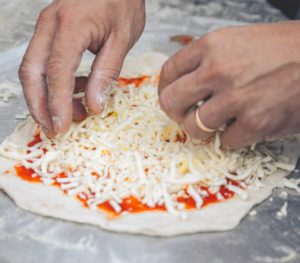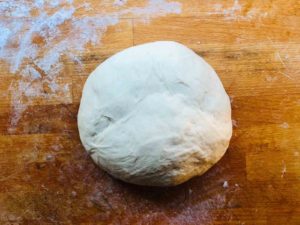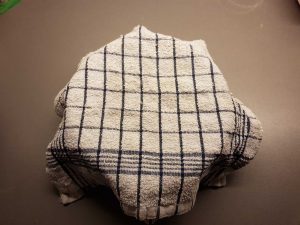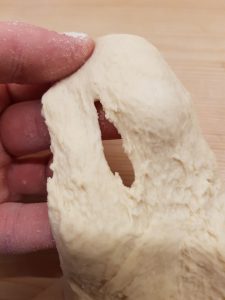Floppy, soggy pizza sucks! And it can be frustrating to figure out why it’s happening. But don’t worry, you’re not alone. Soggy pizza is very common. I’ve therefore put together this article to help you troubleshoot and fix your pizza, so you can make perfectly crispy pizza every time!
This article will explain how you can save a soggy pizza right now the most common mistakes and how to fix them.
What causes soggy pizza?
The reason your pizza is soggy is simply too much moisture. To get crispy pizza the moisture in the crust needs to evaporate during baking. So baking time and temperature play an important role in making crispy pizza.
But starting with a pizza that contains too much moisture, or failing to get rid of that moisture during baking will also cause problems.
The top reasons for soggy pizza are:
- The pizza is undercooked
- The baking surface is not hot enough
- The sauce is too thin
- The cheese or topping contains too much moisture
- Overtopping the pizza
- The crust is too thin or too thick
- The pizza sat for too long before baking
- You didn’t let the pizza sit after baking
- You cut into the pizza too soon
- You didn’t reheat the pizza the right way
How to fix soggy pizza right now
To save your soggy pizza, you need to get rid of excess moisture by baking the pizza longer.
So if your pizza is too soggy, place it back in the oven and let it bake for a few more minutes.
If you use a pizza stone or steel, you can let this reheat for 10-15 minutes before you place the pizza back in the oven. This will give it some extra heat that will help you get rid of the moisture faster, without drying out the crust.
But keep an eye on it to check when it’s done, and to make sure it doesn’t burn.
If the top of the pizza is done before the bottom, you can cover the top of the pizza with aluminum foil to prevent it from burning.
3 stages of soggy pizza
There are 3 stages where pizza can get soggy:
- During baking
- After baking
- Reheating
Each of these stages creates different problems, so I will go through each of them and show you how to make your pizza crispy.
The top reasons for soggy pizza and how to prevent it
The pizza is undercooked
Underbaking pizza is the most common mistake when people make pizza at home. Underbaking will make soggy pizza and inferior flavor and texture.
To fix undercooked pizza, you need to bake the pizza hotter or longer.
The moisture will evaporate from the crust and make it crispy when you leave the pizza in the oven longer. But you can also increase the temperature to crip it faster.
A hotter, faster bake will give you better pizza because you’ll get a crispy crust without drying it out. This will give you a crust that’s crispy on the outside, yet light and soft on the inside. So bake your pizza at the highest temperature of your oven for the best result.
The baking surface is not hot enough
One of the challenges of a home oven is that the bottom of the pizza doesn’t bake as fast as the top. Something that will result in a soggy crust.
You need a balance between the heat from above and underneath the pizza to get an even bake. Since moisture gets trapped under the pizza, chances are that the top of your pizza will be done before the bottom. Especially if you use a regular baking sheet. And you might end up with burnt toppings before the bottom is done.
To fix this, you should use a pizza stone or
A pizza stone or steel is simply a baking surface you preheat in the oven and bake the pizza directly on. The extra heat will bake the bottom of the pizza faster, and make it crispier. Just like in a proper
Personally, I prefer a
If you want to learn more about baking pizza on steel, check out this easy step-by-step guide to perfect pizza using a pizza steel.
The sauce is too thin
Another source of moisture is too thin tomato sauce. If the pizza sauce has too much water, the dough will absorb moisture from the sauce which will prevent it from getting crispy.
The two main categories of sauce are cooked and uncooked pizza sauce. And they require two different methods to thicken.
Cooked tomato sauce
If you use cooked tomato sauce, the easiest way to thicken it is to let it simmer longer to reduce it. But make sure to not use too high a temperature, since this can burn the sauce.
Uncooked tomatoes
Especially for Neapolitan pizza, uncooked tomato sauce is common. Either from fresh or canned tomatoes.
Tomato cans contain water, so if you use canned tomatoes, whole peeled tomatoes are the best option. Diced and crushed canned tomatoes usually contain more water and are harder to drain than whole tomatoes.
Drain off the liquids using a fine-mesh strainer, and use only the tomatoes to make your sauce.
It’s also worth mentioning that too much sauce will also make the pizza soggier, so don’t overdo it.
The cheese contains too much moisture
We can all agree that fresh mozzarella on pizza is great on pizza. But you need to be careful because fresh mozzarella contains a lot of water. So if you want to use fresh mozzarella on your pizza, make sure to drain as much moisture as possible.
Click here to see how to drain fresh mozzarella for pizza.
Fresh buffalo mozzarella contains even more water than Fior di latte, so I don’t recommend using it unless you have a proper
Another alternative is to use low-moisture cheese for your pizza.
You should also be careful with high-fat cheese. If the cheese contains too much oil, it can soak into the pizza and make it soggier, but unlike water, the oil will not evaporate in the oven.
The toppings contain too much moisture
Many vegetables contain a lot of water, such as tomatoes and bell pepper. I’m not telling you to not use vegetables on your pizza, but limit the use of high-moisture toppings to prevent sogginess.
Overtopping the pizza
Even if you use the right sauce, cheese, and toppings, putting too much on the pizza will make it soggier. The more you add to your pizza, the more water needs to evaporate in the oven to make it crispy.
Adding a lot of cheese and toppings will also create a cover over the sauce that traps the water, making it harder for it to escape during baking.
So don’t add too much sauce, cheese, and toppings to your pizza.
Too thin crust
If the crust is stretched too thin it’s not able to keep the moisture from the sauce away. You also run the risk of making holes in the crust if you stretch it paper-thin. So you need to make sure your dough isn’t too thin.
Too thick crust
The thicker the crust is the longer it takes to bake. So if you make the crust too thick it can also make it harder to crips. A thicker crust needs more time in the oven to both crips up and bakes through.
The pizza sat for too long before baking
If you leave your topped pizza too long, the dough will absorb moisture from the sauce and toppings. So to avoid soggy pizza, don’t top the pizza until right before baking.
Leaving the pizza too long can also cause other problems, such as sticking. The extra moisture in the dough will make the pizza stick to the countertop or
How to fix soggy pizza after baking
The pizza can be perfectly crispy when you get it out of the oven. But if you don’t handle your pizza properly after baking, it will also make it soggy.
You didn’t let the pizza sit after baking
When you take your pizza out of the oven, it’s piping hot. If you place it directly on a serving plate or cutting board, heat will be trapped under the pizza and create condensation. Condensation is the opposite process of evaporation where the trapped steam turns into liquids. And this liquid will make your perfect crispy crust soggy.
To fix this, you should leave the pizza to steam off on a wire rack for 1-2 minutes before serving.
You cut into the pizza too soon
Let the pizza sit for 1-2 minutes will also help the cheese and sauce set a bit. Which will prevent them from making a mess. If you cut into the pizza too soon, all the liquids will spill all over the place. So let the pizza rest for a couple of minutes before cutting and serving.
Avoid soggy pizza when you reheat it
Pizza can also turn soggy when you reheat it.
How to reheat pizza in the microwave
When you reheat pizza in the microwave it turns floppy and wet. There’s no doubt about it. But it’s possible to mitigate.
To make sure your pizza stays crispy when you reheat it in the microwave, wrap it in paper towels when reheating it. The paper will absorb a lot of the moisture that steams off the pizza and makes it soggy.
The best way to reheat pizza
The best way to reheat pizza is using your oven. It’s not going to be as fast as the microwave but it will result in a crispier and nice pizza. When reheating pizza in the oven, you should do it at a low temperature to avoid drying out the pizza crust too much. Around 10 minutes at 350°F (175°C) should do the trick. If your oven has a broiler or grill function, turn it on at the last minute or so to give the cheese a good melt.
Related
- Is Your Pizza Dough Too Dry? Here is How to fix it! - June 10, 2024
- The Ultimate Guide to the Pizza Dough Windowpane Test - June 8, 2024
- The Ultimate Guide to Autolyse Pizza Dough - June 7, 2024






How many ounces of shredded cheese should be used for a 12 inch pizza
It depends a little bit on the cheese, but 4-6oz is probably a good starting point for a 12-inch pizza.
It depends on the cheese if you’re going to add extra cheeses such as like a three-piece cheetah or four or five cheese pizza you want to have your main cheese which most likely be mozzarella, I’m sure, I would start that at least you know 6 possibly seven or eight oz on a 12-in pizza you might even go four if you add an extra cheese of a different sort. Yeah my name is Barry by the way as well So this is a good advice from Barry to Barry
It depends on the cheese if you’re going to add extra cheeses such as like a three-piece cheetah or four or five cheese pizza you want to have your main cheese which most likely be mozzarella, I’m sure, I would start that at least you know 6 possibly seven or eight oz on a 12-in pizza you might even go four if you add an extra cheese of a different sort. Yeah my name is Barry by the way as well So this is a good advice from Barry to Barry